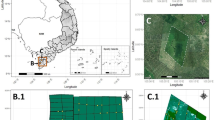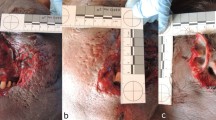Abstract
The ocelot (Felis pardalis) isan endangered neotropical cat distributed within asmall range in the Lower Rio Grande Valley (LRGV), inTexas, U.S.A. Studies of the impacts of environmentalcontaminants in wild cats are few. Approximately onefourth of the estimated population (about 100) ofocelots in the LRGV was sampled to evaluate theimpacts of chlorinated pesticides, polychlorinatedbiphenyls, and trace elements on the population. Hairwas collected from 32 ocelots trapped between 1986–1992,and blood was collected from 20 ocelots trappedbetween 1993–1997. A few blood samples were obtainedfrom individuals recaptured two or three times. Tissue samples from 4 road-killed ocelots were alsoanalyzed. DDE, PCBs, and Hg were some of the mostcommon contaminants detected in hair and blood. MeanHg levels in hair ranged from 0.5 to 1.25 μg g-1 dw,Se from 1.5 to 3.48 μg g-1 dw, and Pb from 0.56 to26.8 μg g-1 dw. Mean DDE concentrations in plasma ranged from 0.005 μg g-1 ww to 0.153 μg g-1 ww, and PCBs ranged from 0.006 μg g-1 ww to 0.092 μg g-1 ww. Mean Hg levels in red blood cells rangedfrom 0.056 μg g-1 dw to 0.25 μg g-1 dw. Concentrations of DDE, PCBs, or Hg, did not increasesignificantly with age, although the highestconcentrations of DDE and Hg were found in olderanimals. Overall, concentrations of DDE, PCBs, and Hgwere low and at levels that currently do not pose anythreat to health or survival of the ocelot. This isfurther supported by good reproduction of the ocelotin the LRGV, where adult females averaged about 1.5kittens/litter. Thus, it seems that the current majorthreat to recovery of the ocelot in the LRGV may behabitat loss, although potential impacts of newgeneration pesticides, such as organophosphorus andcarbamate insecticides need further study.
Similar content being viewed by others
References
Aihara, M. and Sharma, R. P.: 1986, 'Effects of endogenous and exogenous thiols on the distribution of mercurial compounds in mouse tissues', Arch. Environ. Contam. Toxicol. 15, 629-636.
Albanus, L., Frankenberg, I., Grant, C., Von Hartman, U., Jernelov, A., Nordberg, G., Rydalv, M., Schutz, A. and Skerfving, S.: 1972, 'Toxicity for cats of methylmercury in contaminated fish from Swedish lakes and methylmercury hydroxide added to fish', Environ. Res. 5, 425-442.
Ballschmiter, K. and Zell, M.: 1980, 'Analysis of polychlorinated biphenyls (PCB) by glass capillary gas chromatography', Fresenius Z. Anal. Chem. 302, 20-31.
Burger, J., Marquez, M. and Gochfeld, M.: 1994, 'Heavy metals in the hair of opossum from Costa Rica', Arch. Environ. Contam. Toxicol. 27, 472-476.
Burton, G. V., Alley, R. G., Rasmussen, G. L., Orton, P., Cox, V., Jones, P. and Graff, D.: 1977, 'Mercury and behavior in wild mouse populations', Environ. Res. 14, 30-34.
Charbonneau, S. M., Munro, I. C., Nera, E. A., Willes, R. F., Kuiper-Goodman, T., Iverson, F., Moodie, C. A., Stoltz, D. R., Armstrong, F. A. J., Uthe, J. F. and Grice, H.: 1974, 'Subacute toxicity of methylmercury in the adult cat', Toxicol. Appl. Pharmacol. 27, 569-581.
Clark Jr., D. R., Ogasawara, P. A., Smith, G. J. and Ohlendorf, H. M.: 1989, 'Selenium accumulation by raccoons exposed to irrigation drainwater at Kesterson National Wildlife Refuge, California, 1986', Arch. Environ. Contam. Toxicol. 18, 787-794.
Cumbie, P. M.: 1975, 'Mercury in hair of bobcats and racoons', J. Wildl. Manage. 39, 419-425.
Elliott, J. E. and Shutt, L.: 1993, 'Monitoring organochlorines in blood of sharp-shinned hawks migrating through the Great Lakes', Environ. Toxicol. Chem. 12, 241-250.
Emmons, L. H.: 1987, 'Comparative feeding ecology of felids in a neotropical rainforest', Behav. Ecol. Sociobiol. 20, 271-283.
Facemire, C. F., Gross, T. S. and Guillette Jr., L. J.: 1995, 'Reproductive impairment in the Florida panther: nature or nurture?', Environ. Health Perspect. 103, 79-86.
Gardner, S. W., Kendall, D. R., Odom, R. R., Windom, H. L. and Stephens, J. A.: 1978, 'The distribution of methylmercury in a contaminated salt marsh ecosystem', Environ. Pollut. 15, 243-251.
Henny, C. J. and Meeker, D. L.: 1981, 'An evaluation of blood plasma for monitoring DDE in birds of prey', Environ. Pollut. 25, 291-304.
Kamrin, M. A. and Ringer, R. K.: 1994, 'PCB residues in mammals: A review', Toxicol. Environ. Chem. 41, 63-84.
Kamrin, M. A. and Ringer, R. K.: 1996, 'Toxicological Implications of PCB Residues in Mammals', in W. N. Beyer, G. H. Heinz and A. W. Redmon-Norwood (eds.), Environmental Contaminants in Wildlife, Lewis Publishers, New York, NY, pp. 153-163
Konecny, M. J.: 1989, 'Movement Patterns and Food Habits of Four Sympatric Carnivore Species in Belize, Central America', in K. H. Redford and J. F. Eisenberg (eds.), Advances in Neotropical Mammalogy, Sandhill Crane Press, Gainsville, Florida, pp. 243-264.
Laack, L. L.: 1991, 'Ecology of the Ocelot (Felis pardalis) in south Texas', MS Thesis. Texas A&I University, Kingsville, Texas.
Leonards, P. E. G., Van Hattum, B., Cofino, W. P. and Brinkman, U. A. T.: 1994, 'Occurrence of non-ortho, mono-ortho, and di-ortho-substituted PCB congeners in different organs and tissues of polecats (Mustela putorius L.) from The Netherlands', Environ. Toxicol. Chem. 13, 129-142.
Mondolfi, F.: 1986, 'Notes on the Biology and Status of Wild Cats in Venezuela', in S. D. Miller and D.E. Everett (eds.), Cats of the World: Biology, Conservation, and Management. National Wildlife Federation, Washington, DC, pp. 125-146.
Mora, M. A. and Wainwright, S. E.: 1998, 'DDE, mercury, and selenium in biota, sediments, and water of the Rio Grande-Rio Bravo Basin, 1965-1995', Rev. Environ. Contam. Toxicol. 158, 1-52.
Mora, M. A., Auman, H. J., Ludwig, J. P., Giesy, J. P., Verbrugge, D. A. and Ludwig, M. E.: 1993, 'Polychlorinated biphenyls and chlorinated insecticides in plasma of Caspian terns: Relationships with age, productivity, and colony site tenacity in the Great Lakes', Arch. Environ. Contam. Toxicol. 24, 320-331.
Navarro-Lopez, D.: 1985, 'Status and distribution of the ocelot (Felis pardalis) in South Texas', Unpublished MS Thesis. Texas A&I University, Kingsville, Texas.
Roelke, M. E., Schultz, D. P., Facemire, C. F. and Sundlof, S. F.: 1991, 'Mercury contamination in the free-ranging endangered Florida panther (Felis concolor coryi)', Proc. Am. Assoc. Zoo. Vet. 20, 277-283.
Sericano, J. L., Atlas, E. L., Wade, T. L. and Brooks, J. M.: 1990, 'NOAA's status and trends mussel watch program: chlorinated pesticides and PCBs in oysters (Crassostrea virginica) and sediments from the Gulf of Mexico, 1986-1987', Mar. Environ. Res. 29, 161-203.
Tewes, M. E.: 1986, 'Ecological and behavioral correlates of ocelot spatial patterns', Ph.D. Dissertation. University of Idaho, Moscow, ID.
Tewes, M. E. and Everett, D. D.: 1986, 'Status and Distribution of the Endangered Ocelot and Jaguarundi in Texas', in S. D. Miller and D. D. Everett (eds.), Cats of the World: Biology, Conservation, and Management, Texas A&I University, Kingsville, Texas, pp. 147-158.
Texas Department of Health: 1992, 'An investigation of a cluster of neural tube defects in Cameron County, Texas', July 1 1992, Austin, Texas.
Thompson, D. R.: 1996, 'Mercury in Birds and Terrestrial Mammals', in W. N. Beyer, G. H. Heinz and A. W. Redmon-Norwood (eds.), Environmental Contaminants in Wildlife, Lewis Publishers, New York, NY, pp. 341-356.
U.S. Fish and Wildlife Service: 1982, 'Endangered and Threatened Wildlife and Plants; Endangered Status for U.S. Population of the Ocelot', Federal Register 47, 31670-31672.
U.S. Fish and Wildlife Service.: 1990, 'Listed Cats of Texas and Arizona Recovery Plan (with emphasis on the ocelot)', U.S. Fish and Wildlife Service, Albuquerque, New Mexico, 131 pp.
Wang-Andersen, G., Skaare, J. U., Prestrud, P. and Steinnes, E.: 1993, 'Levels and congener pattern of PCBs in Arctic fox, Alopex lagopus, in Svalbard', Environ. Pollut. 82, 269-275.
Wolfe, M. F., Schwarzbach, S. and Sulaiman, R.: 1998, 'Effects of mercury on wildlife: A comprehensive review', Environ. Toxicol. Chem, 17, 146-160.
Woodroffe, R. and Ginsberg, J. R.: 1998, 'Edge effects and the extinction of populations inside protected areas', Science 280, 2126-2128.
Woodward, D. W.: 1980, 'The ocelot. Selected vertebrate endangered species of the seacoast of the United States', Fish and Wildlife Service FWS/OBS-80/01.9.
Wren, C. D.: 1986, 'A review of metal accumulation and toxicity in wild mammals. I. Mercury', Environ. Res. 40, 210-244.
Author information
Authors and Affiliations
Corresponding author
Rights and permissions
About this article
Cite this article
Mora, M.A., Laack, L.L., Clare Lee, M. et al. Environmental Contaminants in Blood, Hair, and Tissues of Ocelots from the Lower Rio Grande Valley, Texas, 1986–1997. Environ Monit Assess 64, 477–492 (2000). https://doi.org/10.1023/A:1006233509475
Issue Date:
DOI: https://doi.org/10.1023/A:1006233509475




